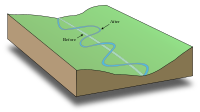
Photo from wikipedia
Abstract In this study, we examined the ASCAT backscatter data from Metop-A from 2007 to 2016 to characterize spatial and temporal variability in the vegetation parameters of the TU Wien… Click to show full abstract
Abstract In this study, we examined the ASCAT backscatter data from Metop-A from 2007 to 2016 to characterize spatial and temporal variability in the vegetation parameters of the TU Wien Soil Moisture Retrieval approach (TUW SMR) across the North American Grasslands. The vegetation parameters are the slope and curvature of a second order Taylor polynomial used to describe the incidence angle dependence of backscatter σ°. A recent development allows the vegetation parameters to be determined dynamically using the local slope values within a prescribed temporal window. Seasonal, interannual and diurnal variations in the vegetation parameters were found to vary across grassland cover types, reflecting variations in soil moisture availability and growing season length. While the slope has always been considered a measure of vegetation density, our results show that curvature also contains information about vegetation. Drought events in 2011 and 2012 resulted in extensive negative σ 40 ∘ and soil moisture anomalies during the maximum biomass period. Contiguous anomalies in slope and curvature were observed where the severity and persistence of the drought were enough to impact vegetation. Observed diurnal differences in slope and curvature suggest that daily moisture transport within the vegetation influences the relative dominance of scattering from the vegetation and soil surface.
Journal Title: Remote Sensing of Environment
Year Published: 2019
Link to full text (if available)
Share on Social Media: Sign Up to like & get
recommendations!